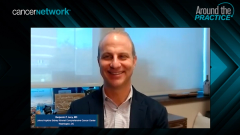
CheckMate-816: Neoadjuvant Chemoimmunotherapy for NSCLC
Shared insight on the CheckMate-816 trial and how immunotherapy may have a role in the neoadjuvant setting of non–small cell lung cancer.
Episodes in this series

Transcript:
Charu Aggarwal, MD, MPH:I think this calls for a recap on some of the studies. Ben, would you take us through the CHECKMATE 816 data that will be subsequently presented at the AACR [American Association for Cancer Research] meeting this year?
Benjamin P. Levy, MD: Yes, this is what we’ve been talking about. This was a seminal study potentially, and I think a practice-changing study, that looked at roughly 350 patients with newly diagnosed resectable IB to IIIA non–small cell lung cancer based on the seventh edition. Patients importantly did not have any known EGFR or ALK mutations or ALK alterations. They were randomized to 3 cycles of neoadjuvant chemotherapy versus 3 cycles of neoadjuvant chemotherapy plus immunotherapy [IO], asking the question whether the addition of immunotherapy is beneficial to chemotherapy in the neoadjuvant setting. Patients got surgery within 6 weeks post-treatment, and then they had the option of getting adjuvant chemotherapy or RT [radiotherapy] as well. This is where things got interesting.
The primary end point was complete pathologic response [pathCR], and that was defined as zero residual viable tumor cells, both in the primary tumor and the sample lymph nodes. I’ll cut to the chase with the primary end point. The complete pathologic response rate, meaning no viable tumor left in either the tissue or lymph node, was 24%, a quarter of patients roughly, in the neoadjuvant chemotherapy/IO arm versus only 2% in the chemotherapy alone arm. If you looked at the patients who actually went on to resection, the complete pathologic response was 30%, so pretty remarkable. I think we need to keep in mind that two-thirds of patients in this study had stage IIIA disease, which is a large number of patients. These are bad actors, as Harvey said. That subset analysis showed a benefit, at least in the forest plot. There have been 2 subsequent iterations of these data that I think are important, and that’s looking at the surgical approaches. I’m sure Harvey can talk about this better than I can.
The bottom line is that adding immunotherapy to chemotherapy didn’t seem to disrupt surgery, make surgery more difficult, or lead to worse outcomes from a surgical standpoint. In fact, there were more pneumonectomies in the chemotherapy arm than there were in the chemotherapy/IO arm, and there was a higher chance of doing lobectomy in the chemotherapy/IO arm versus the chemotherapy arm alone. I think what we learned more recently are the event-free survival and OS [overall survival] data. Maybe we’ll see more of this. We’ve seen preliminary snapshots of this, that the hazard ratio is 0.63 for event-free survival with neoadjuvant chemotherapy/IO versus neoadjuvant chemotherapy.
You can put this all together and say this has serious traction. You’ve got a complete pathologic response rate that is quite high. We think, based on earlier data, that correlates to better outcomes. We now have early snapshots of event-free survival and overall survival. This didn’t seem to disrupt the type of surgery that was done or the safety with surgery. Again, I’ll leave Harvey to talk about that. But certainly all 3 of these components here, I think, create a new standard of care, and a competing standard of care, and have allowed us to relook at these patients and talk about them in multidisciplinary conference the way we’ve been discussing on this panel.
Charu Aggarwal, MD, MPH: That was a great summary, Ben. One of my hesitations to incorporate this for all my patients has been the fact that I don’t know if the benefit is going to be as impactful in non–stage IIIA patients. Will patients with relatively smaller tumors without a lack of lymph node involvement benefit to the same extent? Secondly, I think this is a really good way to establish proof of concept for patients who receive a pathCR; this is great. I think those patients are going to have definitely an improvement in overall survival. I think pathCR is one of the strongest predictors, at least as seen in other solid tumors. But I worry about what we do for about three-fourths of the patients who didn’t achieve a pathCR. We don’t have any data on how to integrate subsequent therapy. We certainly know that 3 cycles of chemotherapy is probably OK, but what about additional immunotherapy? That’s my dilemma in terms of what do we do for the patients who maybe have an NPR [nonprogression rate] or maybe still have residual disease? Harvey, do you think about this differently?
Harvey I. Pass, MD: No, I’m right with you. I thought that at the ASCO [American Society of Clinical Oncology] presentation, at the surgery meeting, they broke out the earlier [stage] patients also. The complete response for them was double what it was for the stage IIIAs. It was higher, as I remember from the presentation. I agree that this whole concept of worrying about the fibrosis and worrying about this and that has sort of passed us. We know that we can do this with minimally invasive operations now. The standard is becoming either VATS [video-assisted thoracoscopic surgery] or robotics to do these types of operations. This may take a little longer, but at the same time, it’s just as safe. Then with regard to the postoperative management with any complications, it’s really not any different than what we’ve found in the Society of Thoracic Surgeons database.
These patients though, I agree, need some sort of adjuvant therapy, if they can tolerate it after the operation, and if they want it. I think they still have a very high chance they’re going to recur. We don’t know completely what those data are going to be, so I would certainly be more aggressive, especially in the higher stage patients, with regard to adjuvant [treatment]. My own question, Charu, is that in the future, when you have the small lesions where we see good pathologic response rates, do you need to have both chemotherapy and immunotherapy if you have a high PD-L1? Which is another question that we worry about with the LCMC3 [trial]. Is it possible to just give immunotherapy alone as an induction for these patients if they have a high PD-L1?
Transcript edited for clarity.
Newsletter
Stay up to date on recent advances in the multidisciplinary approach to cancer.























































































